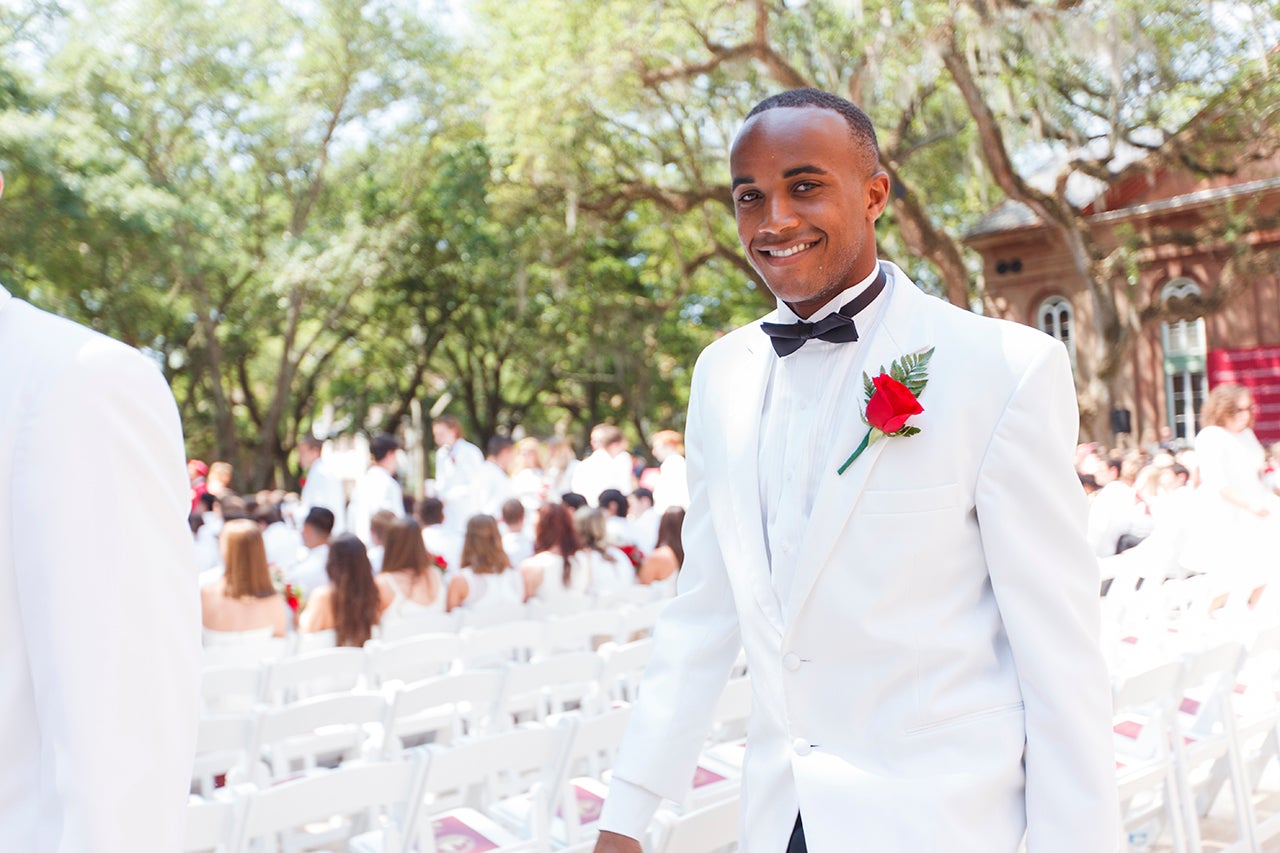Anyone who has had the pleasure of sitting beneath the live oaks in the Cistern Yard on a warm May day to see grads clad in white can tell you: Spring Commencement at the College of Charleston is truly unique.
The College has performed its commencement ceremonies on the iconic campus green for nearly 90 years, making for one of the most memorable graduations in the South. And like any storied ceremony, this one is steeped in tradition, each with its own backstory.
The White Dinner Jackets and Dresses
Seeing undergrads sitting on the Cistern stage, decked out in brilliant white jackets and dresses, evokes more than just a little Southern charm. And it’s a tradition that is today is matched by no other college in South Carolina and perhaps the rest of the country.
But students graduating in suits wasn’t so uncommon in the College’s earlier years. According to Nan Morrison’s A History of College of Charleston 1936-2008, traditional caps and gowns came late to most southern schools, namely because of poverty. Photos from many CofC commencements in the 19th and early 20th centuries show students wearing formal suits, including the Class of 1904 (pictured at right) which graduated in black blazers and light trousers.
According to Morrison’s book, the attire frustrated some members of the faculty, who argued that the graduation garb emphasized the social, economic and gender differences between students rather than their academic achievements.
But students disagreed. An editor of the College’s year book, the Meteor, wrote in 1937: ” The College has a very definite and strong feeling of its own. Evidences of this spirit are found in such traditions as… the lack of cap and gowns at graduation.”
President Harrison Randolph, the College’s longest-serving chief administrator and for whom Randolph Hall is named, explained his reasoning for CofC’s attire in a letter to a New York University faculty member ahead of the 1938 commencement.
 “I ought to say that we never use academic costume,” Randolph wrote in the letter housed at the Special Collections of the Addlestone Library. “Being inclined to democratic simplicity, the College has always used at academic ceremonies the attire that would be worn at any other serious occasion. Accordingly for the exercises, in the afternoon any form of day-time attire would be suitable.”
“I ought to say that we never use academic costume,” Randolph wrote in the letter housed at the Special Collections of the Addlestone Library. “Being inclined to democratic simplicity, the College has always used at academic ceremonies the attire that would be worn at any other serious occasion. Accordingly for the exercises, in the afternoon any form of day-time attire would be suitable.”
But why white? Fashion etiquette — and Charleston’s sultry springtime climate — may offer an explanation.
For one, modern Spring Commencements at the College have been held in May or June. This means commencement almost always fell after Easter, when it was deemed acceptable by the upper echelons of 19th and 20th century society to wear white.
And as any CofC grad will tell you — Charleston is already hot by May or June. And because white reflects sunlight, it makes for a better midday outfit than any other color.
Randolph, in that same letter to the NYU faculty member, referenced the heat that should be expected on commencement day.
“As the weather is apt to be warm many of those on the rostrum wear white thin suits which are so usual to our warm climate,” he wrote.
As the years went by, the white dinner jackets and dresses crossed over from practical convenience to celebrated tradition, and by 1970, an administrator writing to potential guests bragged about how the College was one of the “few institutions left” where men and women opt for white jackets and dresses over academic attire.
Today, every undergrad who graduates in the spring wears white. In the winter, students follow the “no white after Labor Day” etiquette that has become verboten in America and wear black tuxedos and dresses. (Randolph also mentioned in his letters that evening commencements would require students to wear formal evening suits).
The Cistern
With its wrought iron fences, historic buildings, live oaks and Spanish moss, the Cistern Yard represents one of the country’s most beautiful campus greens. And since the space is such an integral part of so many CofC students’ lives, it would make sense that it would serve as the backdrop for commencement every year.
But that has not always been the case.
Commencement in the Cistern Yard did not begin until 1932, according to school records at Addlestone Library. In fact, the Cistern itself wasn’t even built until 1857 (as a reservoir to fight fires.)
Early commencements were held in what is now Randolph Hall, with most taking place in the College Chapel (now Alumni Memorial Hall). Other commencements in the 19th and early 20th centuries were held off campus, at churches and other meeting halls throughout downtown Charleston.
At least one graduating class didn’t like graduating off campus, though. In a letter republished in College of Charleston Voices, the Class of 1870 asked for the College’s chapel to be enlarged so commencement exercises could resume on campus.
“As the college is the proper place where its commencement should be held and as the College Chapel is too small for our purpose, it is earnestly desired that the chapel should be enlarged to contain the audience present on those occasions,” the students wrote.
 But with the Great Depression in full swing by 1932, the difficult decision was made to move that year’s Spring Commencement back to campus. And because the Cistern Yard was probably the only place large enough to host students, their families, faculty and guests, the ceremony was moved to the campus green.
But with the Great Depression in full swing by 1932, the difficult decision was made to move that year’s Spring Commencement back to campus. And because the Cistern Yard was probably the only place large enough to host students, their families, faculty and guests, the ceremony was moved to the campus green.
According to a transcript from a 1932 commencement address housed at Addlestone Library, Randolph said the College’s first open-air graduation was on a “simpler scale.”
“On this occasion I find a special satisfaction in holding our commencement amid surroundings which seem sacred to the memory of those who have gone before, those sons of the College whose names and deeds and imperishable words give substance and meaning to what we believe has been the special influence of CofC on the cultural development of this city and section,” he said.
After that, Commencement on the Cistern became the tradition it is today. In honor of the college’s 150th Commencement in 1935, the College paid $208 to a Richmond, Virginia, company to set up enough speakers so all 2,000 people in the Cistern Yard could hear every speech. And by 1943, students could be seen in photos making the iconic walk down Randolph Hall’s steps.
According to Morrison’s book, it didn’t take long for the tradition of “walking across the Cistern” to set in as the College’s most important rite of passage.
Of course, inclement weather has forced changes over the years. Randolph wrote about how ceremonies could be postponed to the evening for rain, and administrators reserved spaces in local churches in case of bad weather later on in the 20th century. Once TD Arena was constructed, it became the go-to rain location.
Roses for Mother’s Day
Commencement on Mother’s Day weekend appears to be a newer tradition at the College.
The College’s first commencement in 1794 was held in October. In 1842, it was on Feb. 22. At some point in the College’s history, commencement was even held in June after the end of classes. But because of the unbearable heat, it was moved back a month.
 By 1924, according to College documents housed at Addlestone Library, the “custom of the College” was to hold commencement “a month in advance of the close of session” in mid June.
By 1924, according to College documents housed at Addlestone Library, the “custom of the College” was to hold commencement “a month in advance of the close of session” in mid June.
That year, commencement was held on Thursday, May 15 – a few days after Mothers Day, which had only been designated a holiday by President Woodrow Wilson 10 years earlier, according to the Deseret News.
Throughout the 20th century, May became the most popular month for commencement, and the ceremonies began to settle out in mid May to match up with contemporary academic calendars — and Mother’s Day weekend.
The roses, however, appear to be an older tradition. Morrison wrote in her book that female students carried carnations during commencement as early as the 1930s. That changed by 1943, when photos show the men in the graduating class wearing rose boutonnieres, while the women were carrying bouquets of six roses.
Today, students can bring their own flowers, and they do not have to be red roses. But the bookstore, which sells the lion’s share of flowers for the event, only stocks roses.








